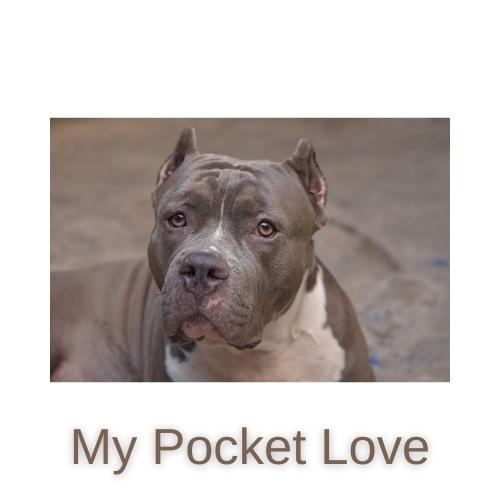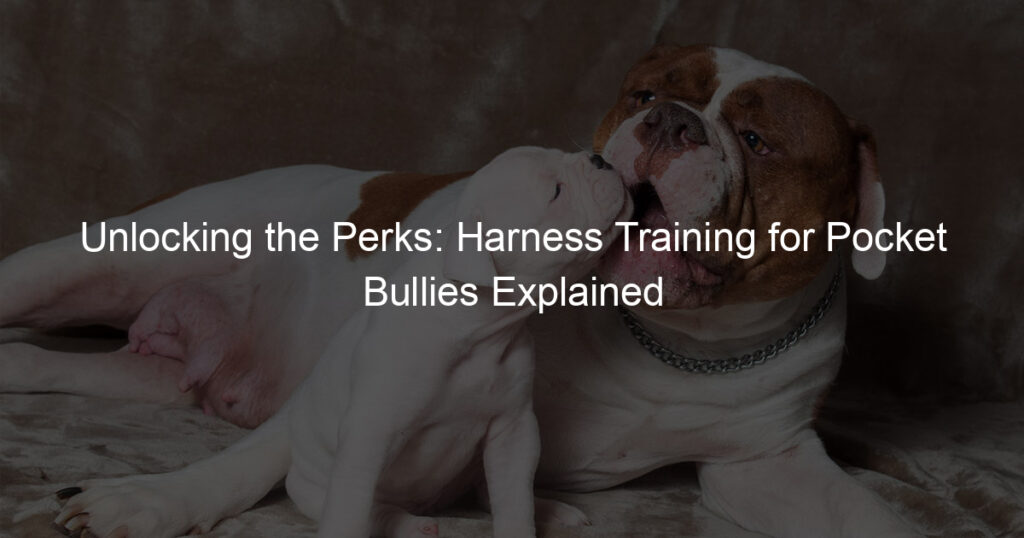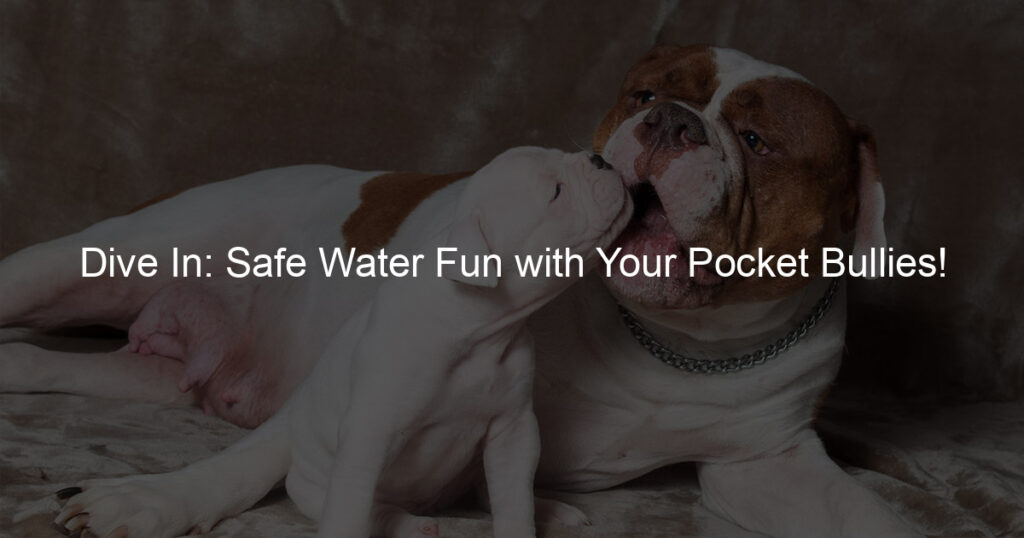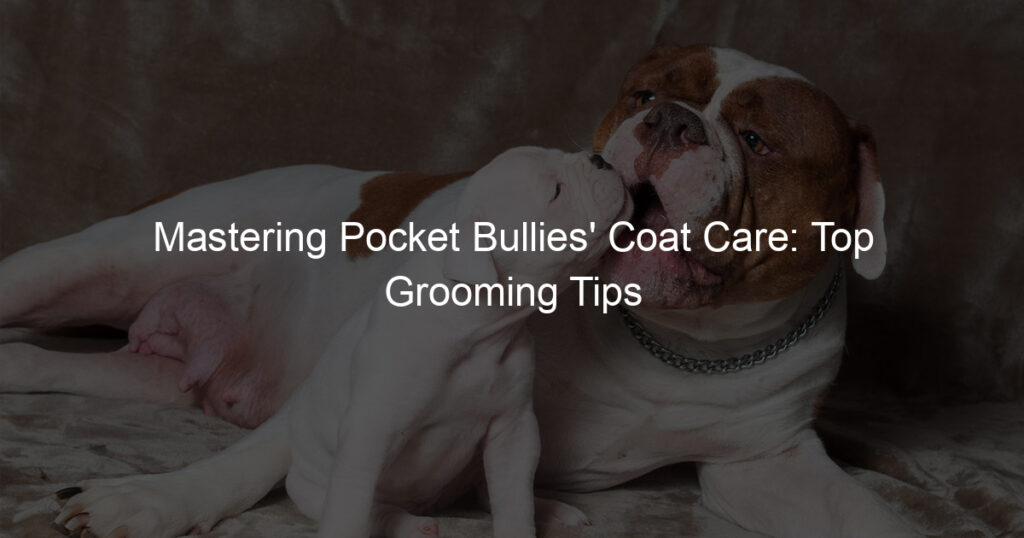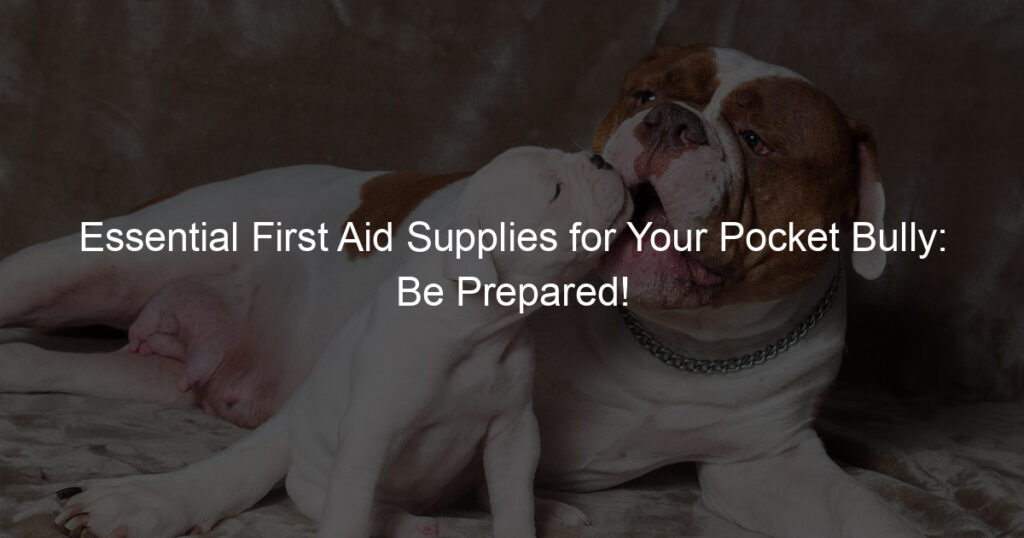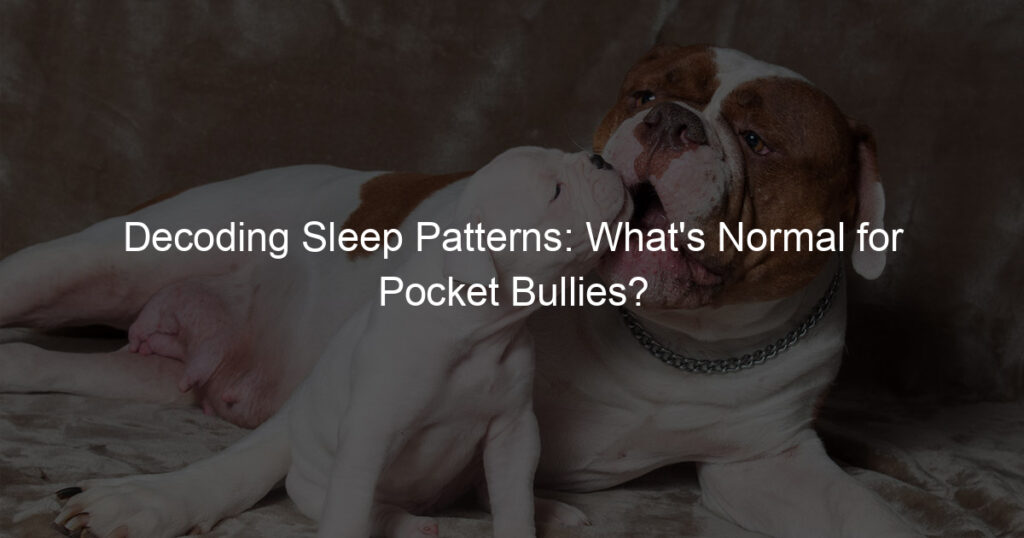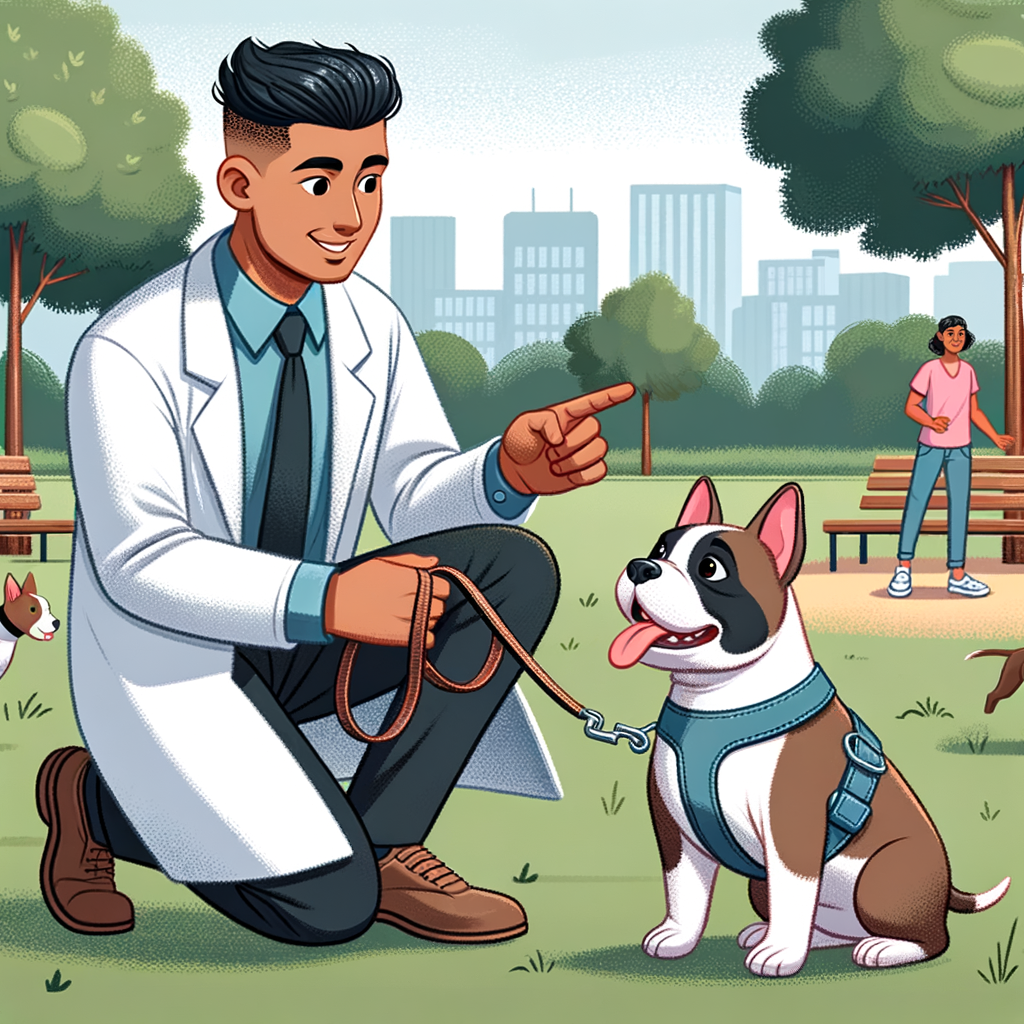
Introduction to Harness Training for Pocket Bullies
Welcome to our comprehensive guide on harness training for Pocket Bullies. This guide is designed to help you understand the concept of harness training and why it is essential for Pocket Bullies. Let’s dive in!
- Understanding the concept of harness training
Harness training is a method used to control and guide dogs during walks or training sessions. Unlike a collar that puts pressure on the dog’s neck, a harness evenly distributes the pressure across the dog’s chest and back, providing better control and reducing the risk of injury. It’s like a seat belt for your dog!
Training your Pocket Bully to wear a harness involves getting them used to the harness, teaching them to associate it with positive experiences, and gradually increasing the time they spend wearing it. It’s a process that requires patience and consistency, but the results are well worth it.
- Why harness training is essential for Pocket Bullies
Pocket Bullies, like all dogs, need regular exercise to stay healthy and happy. However, due to their muscular build and energetic nature, they can be a handful on walks if not properly controlled. That’s where harness training comes in.
A harness gives you better control over your Pocket Bully, making walks safer and more enjoyable for both of you. It also reduces the risk of your Pocket Bully pulling on the leash and potentially hurting themselves. Moreover, a well-trained Pocket Bully is a joy to be around and makes a positive impression on others.
In conclusion, harness training is not just about making walks easier – it’s about ensuring the safety and well-being of your beloved Pocket Bully.
Benefits of Harness Training for Pocket Bullies
Harness training is a great way to improve your Pocket Bullies’ behavior and health. It offers numerous benefits that can make your walks more enjoyable and safer. Let’s take a closer look at these benefits.
Pocket Bullies Training Benefits
- Improved control during walks
- Prevention of injuries and health issues
- Enhanced comfort for the dog
One of the main benefits of harness training is that it gives you better control over your Pocket Bullies during walks. Unlike collars, harnesses distribute pressure evenly across the dog’s body, reducing the risk of your dog pulling and potentially causing harm to themselves or others.
Harnesses are designed to protect your dog’s neck and spine. Traditional collars can cause strain and injury to these areas, especially if your dog has a habit of pulling on the leash. By using a harness, you can prevent these potential health issues.
A well-fitted harness can provide a comfortable and secure fit for your Pocket Bullies. Unlike collars that can cause discomfort and even choking, a harness is designed to fit comfortably around your dog’s body, reducing stress and discomfort.
In conclusion, harness training offers a multitude of benefits for both you and your Pocket Bullies. It not only improves control and prevents potential injuries, but also enhances the overall comfort of your dog. So, why not give it a try and see the positive changes it can bring to your walks?
Advantages of Harness Training
Harness training your pocket bully can bring about numerous benefits. Let’s delve into the key advantages:
- Increased obedience and discipline
- Reduced pulling and tugging
- Improved safety and security
One of the primary benefits of harness training is the increased obedience and discipline it instills in your pocket bully. Harness training provides a structured environment that helps your dog understand what is expected of them. This, in turn, fosters obedience and discipline, making your pocket bully easier to manage and more enjoyable to be around.
Does your pocket bully have a habit of pulling and tugging during walks? Harness training can help with that. Unlike traditional collars, harnesses distribute pressure evenly across your dog’s body, discouraging them from pulling and tugging. This makes walks more enjoyable for both you and your pocket bully.
Lastly, harness training can significantly improve the safety and security of your pocket bully. Harnesses provide better control over your dog, reducing the risk of accidents or injuries. They also prevent your pocket bully from slipping out and running into potentially dangerous situations. In essence, harness training is a proactive step towards ensuring your dog’s safety and security.
Pocket Bullies Behavior Improvement
One of the most significant benefits of harness training is its impact on a Pocket Bully’s behavior. This training method can lead to significant improvements in a dog’s behavior, making them more manageable and enjoyable to be around. Let’s explore how harness training can help in behavior modification and look at a case study that demonstrates this transformation.
- How harness training can help in behavior modification
- Case study: Transformation of a Pocket Bully after harness training
Harness training is a powerful tool for behavior modification in Pocket Bullies. The harness provides a sense of security and control, which can help reduce anxiety and aggressive behavior. When a dog feels secure and controlled, they are less likely to act out in negative ways.
Moreover, the harness allows for better communication between the dog and the owner. By using the harness to guide the dog’s movements, the owner can effectively communicate desired behaviors. This clear communication can help correct unwanted behaviors and reinforce positive ones, leading to a well-behaved and obedient Pocket Bully.
Let’s look at the case of Max, a Pocket Bully who underwent a significant transformation after harness training. Before training, Max was aggressive, anxious, and difficult to manage. His owner struggled to control him, especially during walks and social interactions.
After introducing harness training, Max’s behavior began to change. He became calmer and more obedient. His aggression decreased, and he became more sociable with other dogs and people. His owner reported that walks became more enjoyable, and Max’s overall behavior improved significantly.
This case study demonstrates the power of harness training in behavior modification. It shows how this simple tool can transform a challenging dog into a well-behaved and enjoyable companion.
In conclusion, harness training is an effective method for improving the behavior of Pocket Bullies. It provides a sense of security and control, facilitates clear communication, and can significantly reduce negative behaviors. As seen in Max’s case, the transformation can be remarkable, leading to a happier dog and a more enjoyable pet ownership experience.
Harness Training Techniques for Dogs
Training your dog to walk on a harness can be a rewarding experience for both you and your pet. It not only ensures their safety but also improves their behavior. In this section, we will focus on harness training techniques specifically for Pocket Bullies.
Training Pocket Bullies
Pocket Bullies, despite their compact size, are energetic and strong. Harness training them requires patience, consistency, and the right approach. Let’s explore a step-by-step guide and common mistakes to avoid during harness training.
- Step-by-step guide to harness training a Pocket Bully
- Common mistakes to avoid during harness training
1. Introduce the Harness: Allow your Pocket Bully to sniff and explore the harness. Reward them with treats for their curiosity.
2. Put on the Harness: Gently put the harness on your dog. Make sure it’s not too tight or too loose. Give them a treat once the harness is on.
3. Short Walks: Start with short walks around the house or yard. Gradually increase the duration and distance of the walks.
4. Consistency: Consistency is key. Make sure to practice harness training daily.
5. Positive Reinforcement: Always reward your dog with treats and praises during and after the training.
1. Rushing the Process: Patience is crucial in harness training. Don’t rush your dog into accepting the harness.
2. Incorrect Harness Size: A harness that is too tight can cause discomfort, while one that is too loose can lead to safety issues.
3. Neglecting Consistency: Skipping days between training can confuse your dog and prolong the training process.
4. Not Using Positive Reinforcement: Positive reinforcement encourages good behavior. Not using it can make the training less effective.
Remember, every dog is unique and may respond differently to training. What works for one may not work for another. Therefore, it’s important to understand your Pocket Bully’s personality and adapt the training techniques accordingly.
Harness Training for Small Dogs
Training small dogs with a harness can be a rewarding experience for both the pet and the owner. It not only ensures the safety of the dog, but also helps in establishing a strong bond between the two. The following sections will guide you on how to choose the right harness for your small dog and the techniques for harness training.
- How to Choose the Right Harness for Small Dogs
- Size: The harness should fit your dog snugly, but not too tight. It should not restrict your dog’s movement or breathing.
- Material: Choose a harness made of durable and comfortable material. Nylon and leather are commonly used materials for dog harnesses.
- Design: Harnesses come in different designs. Some are for the chest, others for the back. Choose a design that suits your dog’s size and breed.
- Techniques for Harness Training Small Dogs
- Introduce the Harness: Let your dog sniff and explore the harness first. This will help your dog get used to it.
- Positive Reinforcement: Use treats and praises to encourage your dog when it behaves well with the harness on. This will make the training process more enjoyable for your dog.
- Patience: Harness training takes time. Be patient and consistent with your training sessions.
Choosing the right harness for your small dog is crucial for effective training. Here are some tips to help you make the right choice:
Remember, the right harness is the one that your dog feels comfortable in and you find easy to use.
Once you have the right harness, it’s time to start the training. Here are some techniques that can help:
Remember, every dog is unique. What works for one might not work for another. So, be flexible and adjust your techniques as needed.
In conclusion, harness training for small dogs requires the right harness and effective training techniques. With patience and consistency, your small dog will soon be walking happily and safely with its harness.
Dog Harness Training Benefits
There are numerous benefits to harness training your dog, particularly if you own a pocket bully. Not only does it improve your dog’s behavior, but it also enhances their overall well-being. Let’s delve into the key takeaways from harness training and why every dog owner should consider it.
- Key takeaways from harness training
- Why every dog owner should consider harness training
One of the primary benefits of harness training is that it provides better control over your dog. This is particularly beneficial for pocket bullies, which are known for their strength and energy. A harness allows you to guide your dog without putting pressure on their neck, reducing the risk of injury.
Another significant benefit of harness training is that it discourages pulling. When a dog pulls on a leash attached to a collar, they might still manage to move forward. This can inadvertently reward the pulling behavior. However, a harness will distribute the force across the dog’s body, discouraging them from pulling and making your walks more enjoyable.
Lastly, harness training can also improve communication between you and your dog. By using a harness, you can guide your dog more effectively, helping them understand what you want them to do. This can strengthen your bond and make training sessions more productive.
Every dog owner should consider harness training because it is a humane and effective method of training. It reduces the risk of injuries, provides better control, and improves communication between you and your dog. Additionally, it can make walks and training sessions more enjoyable for both you and your dog.
Moreover, harness training is particularly beneficial for pocket bullies. These dogs are known for their strength and energy, and a harness can provide the control you need without causing discomfort or injury. If you want to ensure that your pocket bully is well-behaved and happy, harness training is a great option to consider.
Conclusion: The Impact of Harness Training on Pocket Bullies
As we wrap up this comprehensive guide on harness training for Pocket Bullies, it’s essential to take a moment to reflect on the significant benefits and impacts this training method can have on these small but mighty dogs.
- Summary of the benefits of harness training
- Final thoughts on harness training for Pocket Bullies
Harness training offers numerous benefits for Pocket Bullies. It not only enhances their physical health by preventing injuries to their neck and spine but also improves their behavior. Harness training provides a sense of security and control, which can significantly reduce aggressive tendencies. It also fosters a stronger bond between the dog and its owner, making walks and outdoor activities more enjoyable.
While harness training may seem daunting at first, the rewards are worth the effort. Pocket Bullies are known for their strength and energy, and harness training is an effective way to channel these traits positively. Remember, patience and consistency are key in this process. With time and practice, your Pocket Bully will become more obedient, happier, and healthier.
In conclusion, harness training is a powerful tool for any Pocket Bully owner. It’s not just about controlling your dog during walks; it’s about building a relationship based on trust and respect. Harness training is a journey, not a destination. So, enjoy the process and celebrate every little progress your Pocket Bully makes.
